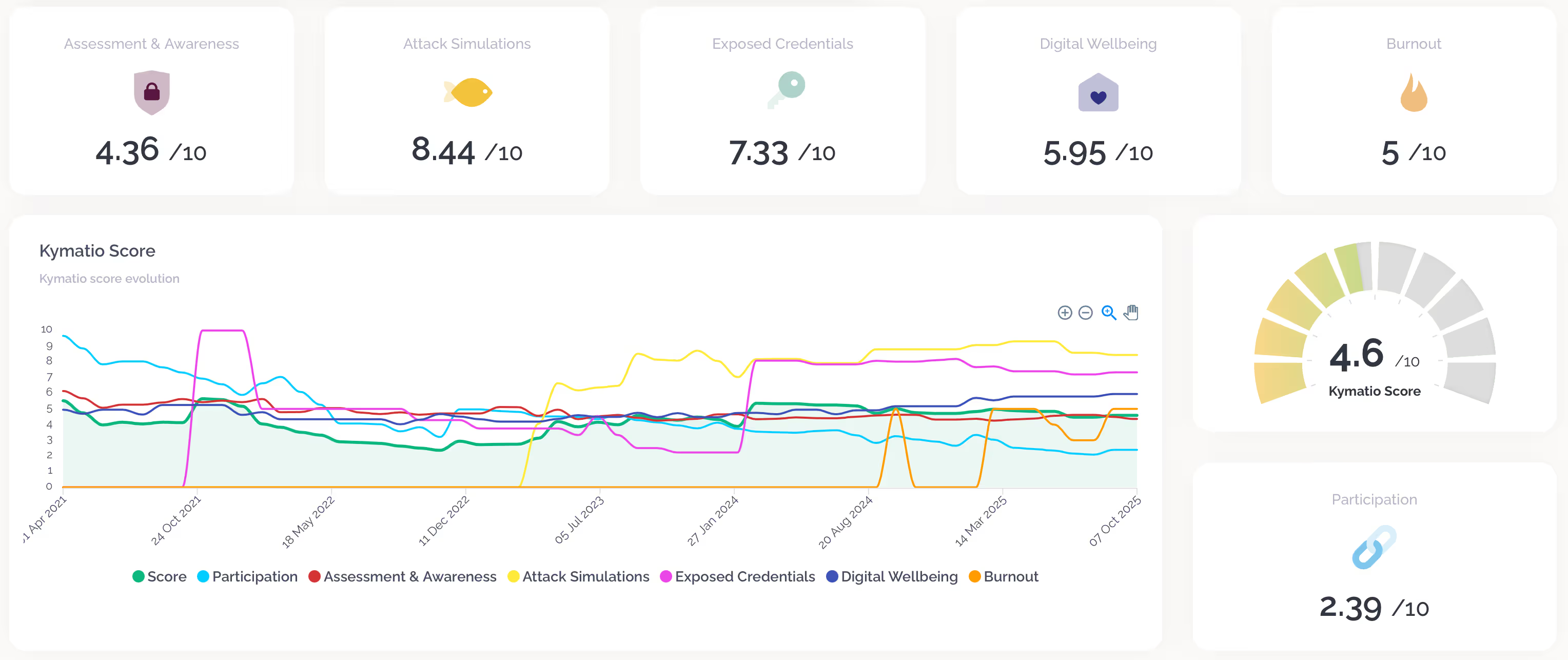CISO Kit 2025: KPIs and Dashboards for Human Cyber Risk Management
Discover the key KPIs for measuring human risk. Create an effective dashboard for the C-suite and comply with the monitoring requirements of the NIS2 Directive.

The NIS2 Directive elevates cybersecurity to the level of the Board of Directors, making it one of its direct and unavoidable responsibilities. It is no longer enough to implement controls; It is now mandatory to demonstrate active supervision and governance based on real risk.
The problem is that traditional metrics, such as the percentage of employees who have completed training, don't answer the key question of the regulator or management: what is our actual level of risk? These effort indicators do not measure behavior and, therefore, the potential impact on the business, a gap that human cyber-risk managementseeks to close.
This CISO Kit 2025 is your practical manual for implementing this new measurement model. We'll show you how to define, measure, and present the human cyber-risk KPIs that really matter, transforming data into strategic intelligence. The objective of this CISO Kit 2025 is clear: to build a robust human cyber-risk management strategy that protects the organization and meets new compliance requirements.
From Operational Metrics to a Strategic Risk Score
To report effectively to the Board, it is necessary to evolve the metrics that are used, and for this a risk dashboard and a Human Risk Score are essential. The most common mistake in human cyber-risk management is to confuse activity with progress. Within the CISO Kit 2025 strategy, we need to move from operational metrics to strategic KPIs that truly inform decision-making.
Measuring activity vs. measuring risk: the basis of a Human Risk Score
100% of your workforce having completed phishing training is an activity metric. It measures the effort invested, but says nothing about its effectiveness. A high level of activity can coexist with a very high human risk, because it does not measure the real behavior of people.
The key is to differentiate between what we do (effort) and what we achieve (result).

What is a Human Risk Score?
A Human Risk Score is a single, weighted indicator that aggregates multiple behavioral KPIs to provide an executive view of the level of risk. It is the translation of complex data into a language that the C-Suite understands: a numerical or qualitative score (e.g. "Low, Medium or High Risk") that shows clear trends.
In the face of the personal responsibility of management imposed by NIS2, presenting an aggregate Human Risk Score is an essential requirement. This approach, central to modern human cyber-risk management, aligns with trends toward Integrated Risk Management (IRM), a concept validated by analysts such as Gartner, which advocates for a unified view of risk across the organization.
The 3 Types of KPIs Essential for Your Human Risk Dashboard
An effective human risk dashboard doesn't just focus on vulnerabilities. To get a complete and balanced view that really works to measure human risk, you need to combine three categories of human cyber-risk KPIs:
1. Vulnerability KPIs: Where are we weakest?
Within human cyber-risk management, these KPIs measure the probability that a human error will occur and be successful. They represent the starting point for measuring risk exposure.
- Click-Through Rate in simulations: This is the most basic reference metric. While it's a limited metric on its own, it gives you a first layer of insight into your template's overall susceptibility to a phishing attempt.
- Credential Submission Rate: This is the true indicator of a critical failure. Measure how many people not only clicked, but entered their credentials or other data on the landing page. A click is a mistake; a credential delivered is a potential breach and the success of an attack technique such as Phishing (T1566) according to the MITRE ATT&CK framework.
- Adherence to Key Policies: It goes beyond confirming the reading of a document, since it measures a behavior that directly impacts the Human Risk Score. It assesses the real compliance with strategic policies, such as the use of password managers, the activation of two-factor authentication (MFA) or the correct classification of information.
2. Resilience KPIs: How quickly do we detect and react?
In human cyber-risk management, vulnerability is inevitable; resilience measures your ability to recover from the impact that a security incident may have. With these KPIs, the focus shifts from measuring failure to assessing the employee's active contribution to the defense.
- Phishing Report Rate: This is arguably the most valuable KPI of all. It does not measure the failure, but the success. A high reporting rate indicates that your employees are an active threat alert sensor, turning the employee into an active, distributed security sensor.
- Mean Time to Report: Measures the speed of your "human firewall." A short time between receiving a malicious email and reporting it to the SOC is crucial to containing an attack before it spreads.
3. Culture and Engagement KPIs: Are our employees a security asset?
These KPIs measure the "health status" of your safety culture, a factor that directly impacts your Human Risk Score in the long term.
- Safety Engagement Index: Measures proactive participation. Do employees attend voluntary training? Do they ask questions about policies? Do they suggest improvements? High engagement is a sign of a positive and entrenched safety culture.
- Digital Wellbeing Metrics: An advanced but increasingly necessary indicator. Factors such as stress, work overload or burnout have a direct impact on care and increase the likelihood of error. Identifying signs of burnout that raise risk is not just an HR task, it's a key piece in proactive risk management.
Designing the Perfect Risk Dashboard: Visualization and Alerts
In human cyber-risk management, defining the right KPIs is the first step. The second, and equally relevant, is to know how to present them in a way that each audience understands the message and can act. A good risk dashboard, such as the one we propose in this CISO Kit 2025, does not have a single view, but several, each with a defined purpose.
Visualization for the C-Suite: Simplicity and Trends
Management doesn't need the granular detail, it needs quick answers to strategic questions. The risk dashboard for the C-Suite should be minimalist and visual.
Focus on showing: the global Human Risk Score, its quarterly evolution, a risk comparison between the main departments and the top 3 risk behaviors. Use high-impact visualizations such as speedometer charts for the global score, trend lines for evolution, and simple bars for comparison. The goal is to facilitate a strategic decision in less than 60 seconds.

Visualization for the Security Team: Detail and Context
This view of your risk dashboard is for analysis and tactical action. In this view, the level of detail is the priority factor. The security team needs access to all granular KPIs, heat maps showing risk by role or geography, and detailed results from each simulation campaign. This view facilitates the understanding of the why behind the Human Risk Score, the identification of pockets of vulnerability and the adjustment of interventions through KPIs.
Configuring Proactive Alerts: From Reaction to Anticipation
A modern risk dashboard cannot be static; its main value lies in the ability to generate proactive risk alerts. Set up thresholds that trigger push notifications if, for example, a critical department's reporting rate falls below an acceptable threshold or if the engagement rate in a simulation exceeds 5%.
These alerts, generated by your risk dashboard, allow for immediate intervention before a risk materializes and help justify the reallocation of resources towards prevention. This continuous monitoring aligns directly with the principles of risk management outlined in standards such as ISO 31000:2018, reinforcing the due diligence required by NIS2.
Frequently Asked Questions


A Human Risk Score is a composite metric that aggregates and weights several behavioral KPIs (such as vulnerability and resilience) into a single indicator, either numerical or qualitative (e.g., Low, Medium, High). The objective of a Human Risk Score is to offer a strategic and quick view of the level of risk, a pillar of human cyber-risk management and of this CISO Kit 2025.


Without a doubt, the Phishing Report Rate. Unlike click-through rate (which measures failure), the report measures the success and active resilience of the workforce. It is the most valuable indicator for building an accurate Human Risk Score, as it demonstrates your employees' ability to act as a first line of defense.


The key is simplicity and a focus on business impact. Use a visual risk dashboard focused on an aggregatedHuman Risk Score. Focus the presentation on showing clear trends, comparisons between departments and the potential impact on business objectives, always avoiding overloading with technical data to facilitate strategic decision-making.


Yes, it is a fundamental tool to demonstrate compliance. The NIS2 Directive requires senior management to not only monitor, but demonstrate active and diligent cyber risk management. A dashboard with up-to-date KPIs provides measurable and ongoing evidence of that monitoring, thus fulfilling one of the central obligations of the regulation.





.png)



